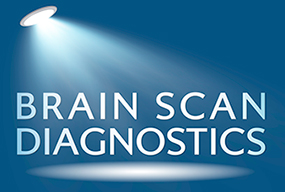Brain Networks
Our brain is always active. Even at rest, it is processing and analyzing information and generating an output. Over the last 20 plus years imaging techniques such as fMRI have been able to identify that some of this activity is organized into networks. Networks are neurons (brain cells) that are working together. Many of these networks have been identified and we focus on the 11 networks listed below because they are widely known and readily measured.
The Auditory Network (Auditory) is symmetrically represented in both brain hemispheres (a left-right symmetrical network). It consists of regions involved in hearing. It encompasses the primary auditory cortex responsible for the sensation of basic characteristics of sound such as pitch and rhythm, and the secondary auditory cortex, important for speech perception.
The Default Mode Network (DMN) is a left-right symmetrical network. It consists of regions most commonly active when a person is not focused on the outside world and the brain is at wakeful rest, such as during daydreaming, mind-wandering and envisioning past or future events. The network activates “by default” when a person is not involved in a task. The DMN has been shown to be negatively correlated with other networks in the brain, such that when the DMN is active, the other networks are inactive, and vice versa.
The Executive Control Network Left (ECN_L) is a network of regions including the left frontal-parietal brain areas, which are generally involved in tasks that rely on paying attention, as well as control processes and working memory. The ECNL is primarily involved in cognitive and language paradigms.
The Executive Control Network Right (ECN_R) is a network of regions including the right hemisphere frontal- parietal areas, which are generally involved in tasks relying on executive functions, such as control processes and working memory. The ECNR relates to perceptual, somesthetic (touch and position) and nociceptive (pain) processing.
The Hippocampal Network (Hippocampal) is left-right symmetrical network that encompasses the hippocampus and amygdala, parts of the limbic system. It plays important roles in the consolidation of information from short-term memory to long-term memory, and in spatial memory that enables navigation.
The Language Network (Language) consists of regions encompassing the Broca and Wernicke areas and is responsible for speech and language comprehension.
The Salience Network (Salience) is a left-right symmetrical network encompassing the anterior insula and dorsal anterior cingulate cortex. It is involved in detecting and filtering emotionally important and relevant stimuli as well as alerting.
The Sensorimotor Network (SN) is a left-right symmetrical network encompassing the somatosensory (post- central gyrus) and motor (pre-central gyrus) areas that are activated during motor tasks.
The Visual Lateral Network (Visual_lateral) is left-right symmetrical network encompassing the middle temporal visual association area and is most important in processing complex (emotional) stimuli. It also is involved in spatial navigation.
The Visual Medial Network (Visual_medial) is left-right symmetrical network encompassing medial regions important in simple visual stimuli (e.g. a flickering checkerboard).
The Visual Occipital Network (Visual_occipital) is a left-right symmetrical network of occipital regions that is important in processing higher-order visual stimuli (e.g. orthography).
